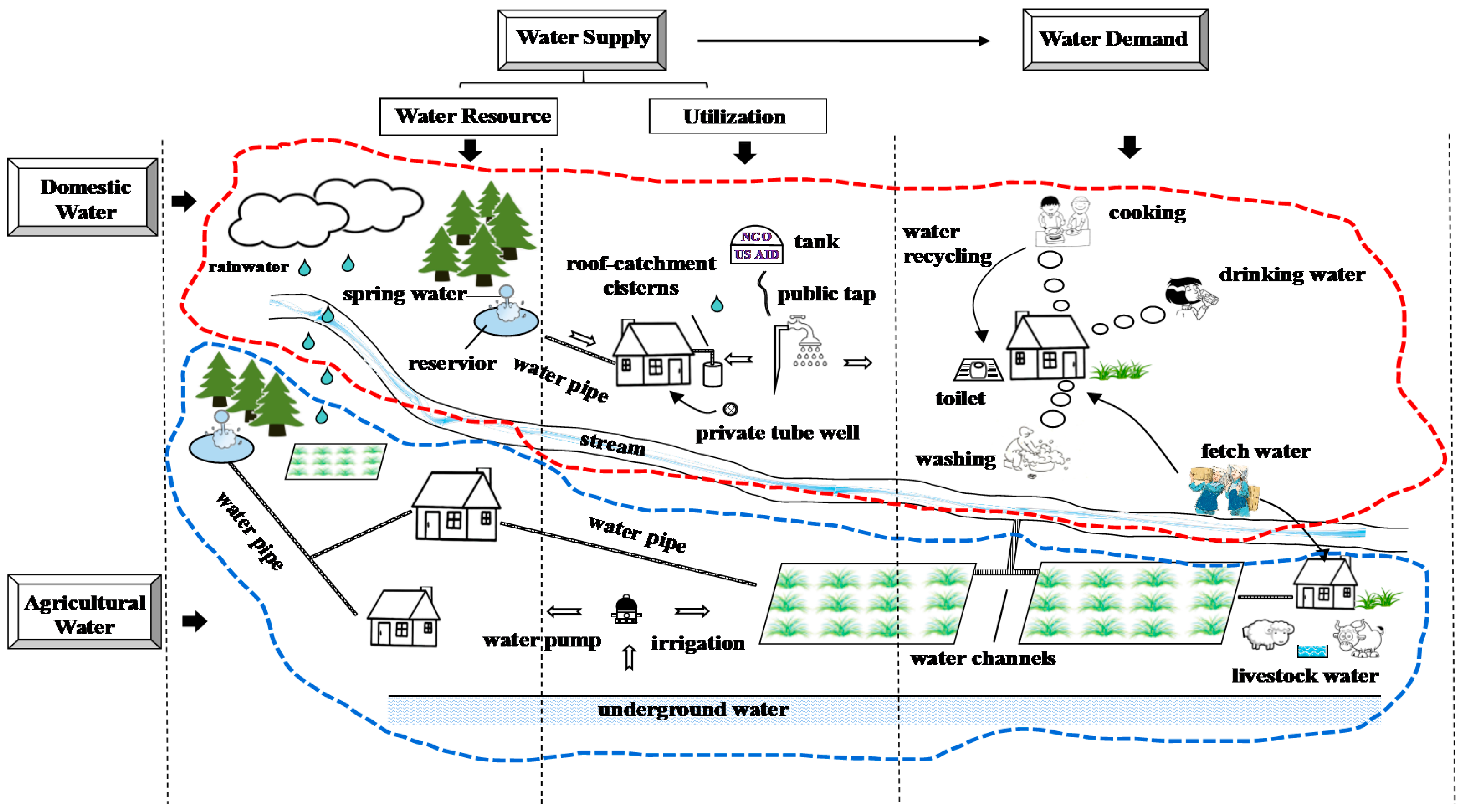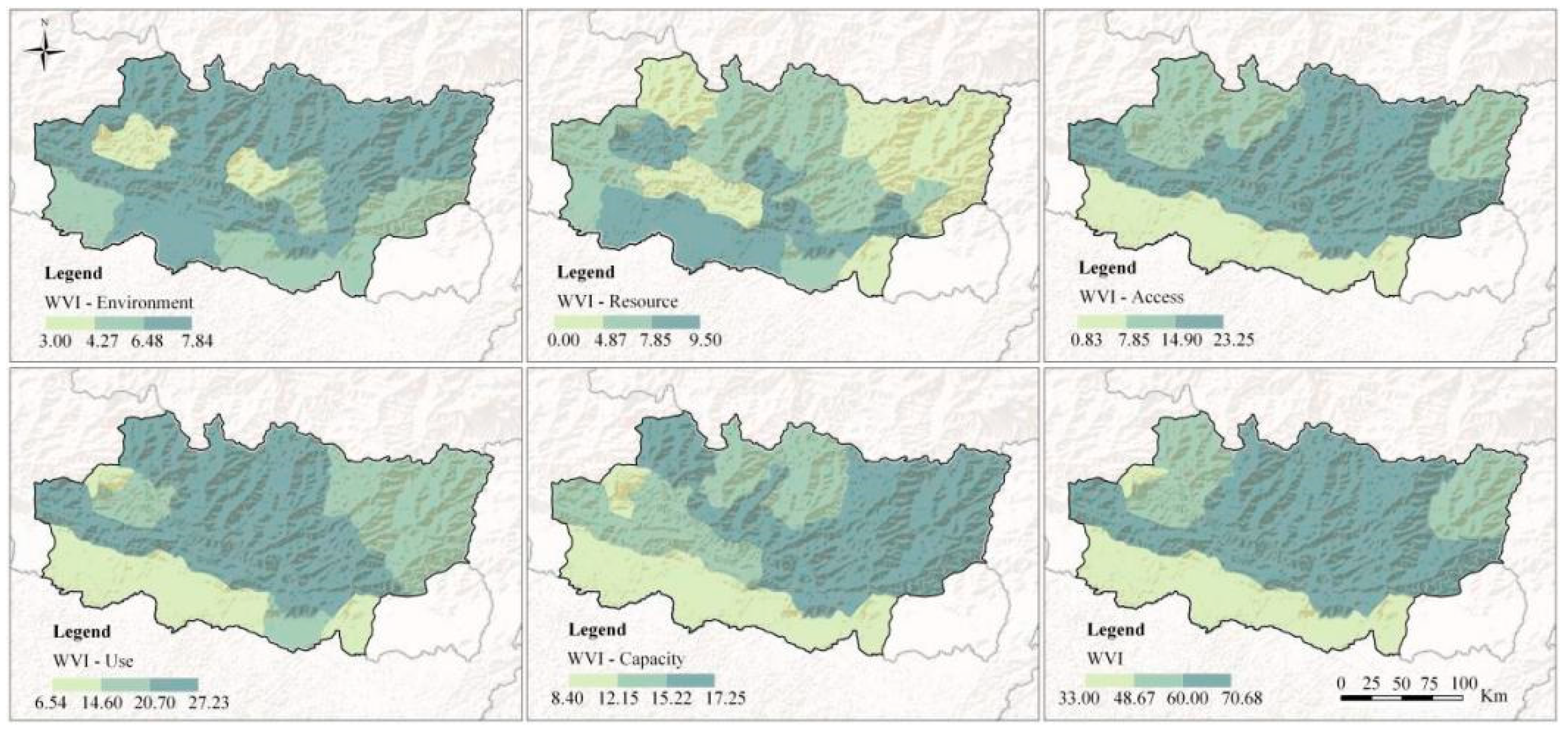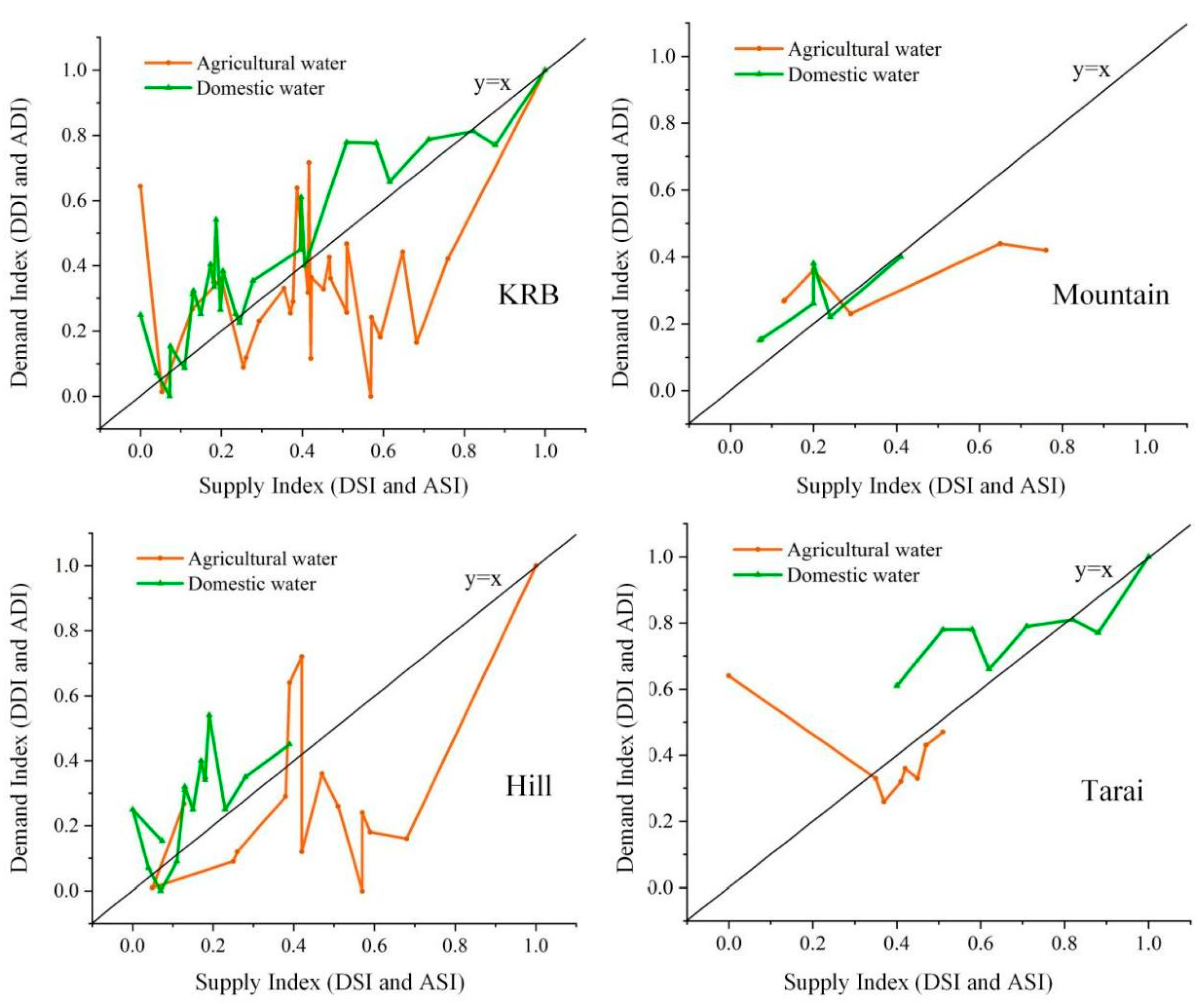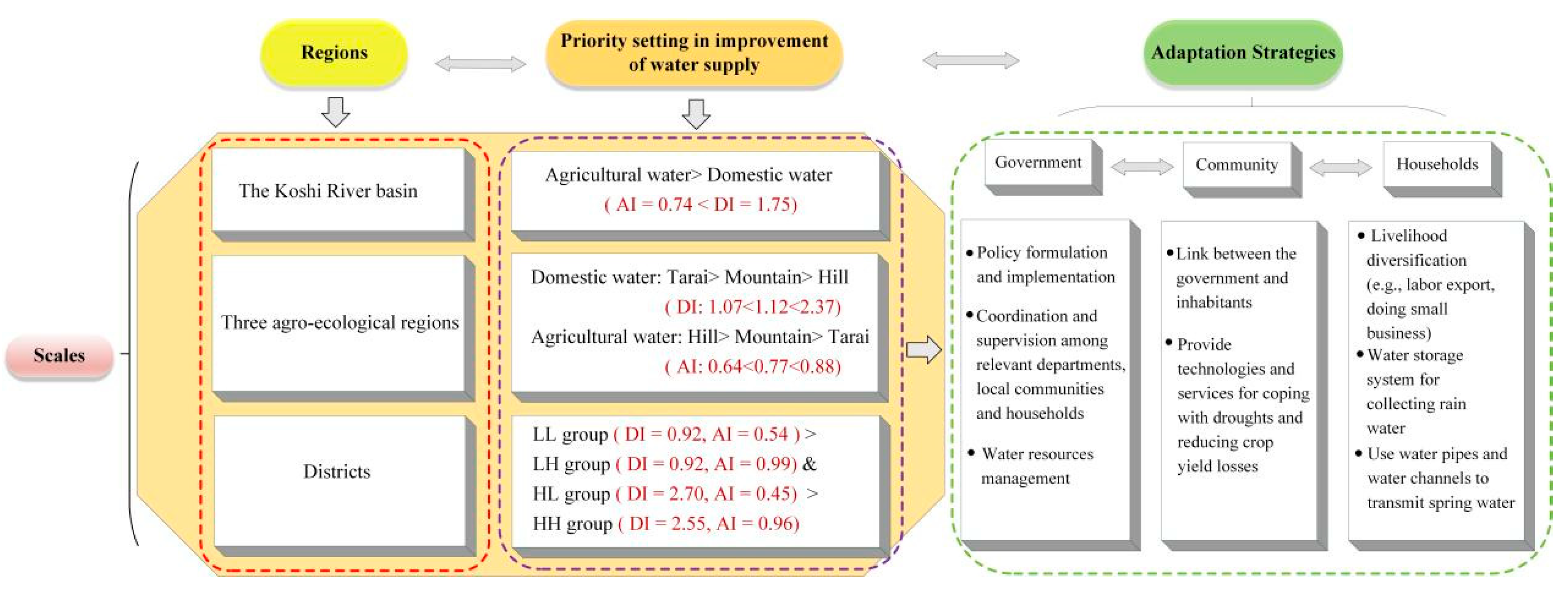Application of a Water Supply-Demand Balance Model to Set Priorities for Improvements in Water Supply Systems: A Case Study from the Koshi River Basin, Nepal
Abstract
:1. Introduction
2. Methodology
2.1. Study Area: The Koshi River Basin of Nepal
2.2. Three Agroecological Regions
2.3. Frameworks for the Water Vulnerability and Supply-Demand Balance Index
2.4. Calculating the WVI and WSDBI
2.4.1. Calculating the WVI: A Composite Indices Method
2.4.2. Calculating the WSDBI
2.5. Data Sources
3. Results
3.1. The WVI for the Koshi River Basin
3.1.1. Comparing the WVI of the Environment, Resource, Access, Use, and Capacity Components
3.1.2. The WVI for Three Agro-Ecological Regions
3.2. The WSDBI for the Koshi River Basin
3.2.1. The DI and AI at Different Scales
3.2.2. The Combination of the DI and AI
4. Discussion
4.1. Comparison of the Water Vulnerability and Supply-Demand Balance Models
4.2. Identifying the Region with the Most Severe Mismatch between Water Supply and Demand
4.3. Priority Setting in the Improvement of Water Supply Systems
4.4. Limitations of This Study
5. Conclusions
Author Contributions
Funding
Data Availability Statement
Acknowledgments
Conflicts of Interest
References
- Sietz, D.; Lüdeke, M.; Walther, C. Categorisation of typical vulnerability patterns in global drylands. Glob. Environ. Chang. 2011, 21, 431–440. [Google Scholar] [CrossRef]
- Xu, Z.; Chau, S.N.; Chen, X.; Zhang, J.; Liu, J. Assessing progress towards sustainable development over space and time. Nature 2020, 577, 74–78. [Google Scholar] [CrossRef] [PubMed]
- Sharafatmandrad, M.; Mashizi, A.K. Temporal and Spatial Assessment of Supply and Demand of the Water-yield Ecosystem Service for Water Scarcity Management in Arid to Semi-arid Ecosystems. Water Resour. Manag. 2021, 35, 63–82. [Google Scholar] [CrossRef]
- Wu, X.Y.; Wu, F.P.; Li, F.; Xu, X. Dynamic Adjustment Model of the Water Rights Trading Price Based on Water Resource Scarcity Value Analysis. Int. J. Environ. Res. Public Health 2021, 18, 2281. [Google Scholar] [CrossRef] [PubMed]
- Balasubramanya, S.; Stifel, D. Viewpoint: Water, agriculture and poverty in an era of climate change: Why do we know so little? Food Policy 2020, 93, 101905. [Google Scholar] [CrossRef]
- Baah-Kumi, B.; Ward, F.A. Poverty Mitigation through Optimized Water Development and Use: Insights from the Volta Basin. J. Hydrol. 2020, 582, 124548. [Google Scholar] [CrossRef]
- Mehboob, M.S.; Kim, Y. Effect of climate and socioeconomic changes on future surface water availability from mountainous water sources in Pakistan’s Upper Indus Basin. Sci. Total Environ. 2021, 769, 144820. [Google Scholar] [CrossRef]
- Delpla, I.; Proulx, F.; Rodríguez, M. A methodology to prioritize spatio-temporal monitoring of drinking water quality considering population vulnerability. J. Environ. Manag. 2020, 255, 109869. [Google Scholar] [CrossRef]
- Pakhtigian, E.L.; Jeuland, M.; Dhaubanjar, S.; Pandey, V.P. Balancing intersectoral demands in basin-scale planning: The case of Nepal’s western river basins. Water Resour. Econ. 2020, 30, 100152. [Google Scholar] [CrossRef]
- Li, M.; Long, K. Direct or Spillover Effect: The Impact of Pure Technical and Scale Efficiencies of Water Use on Water Scarcity in China. Int. J. Environ. Res. Public Health 2019, 16, 3401. [Google Scholar] [CrossRef] [Green Version]
- Manandhar, S.; Pandey, V.P.; Kazama, F. Application of Water Poverty Index (WPI) in Nepalese context: A case study of Kali Gandaki River Basin (KGRB). Water Resour. Manag. 2012, 26, 89–107. [Google Scholar] [CrossRef]
- Koirala, S.; Fang, Y.; Dahal, N.M.; Zhang, C.; Pandey, B.; Shrestha, S. Application of Water Poverty Index (WPI) in Spatial Analysis of Water Stress in Koshi River Basin, Nepal. Sustainability 2020, 12, 727. [Google Scholar] [CrossRef] [Green Version]
- Raskin, P.; Gleick, P.; Kirshen, P.; Pontius, G.; Strzepek, K. Comprehensive assessment of the freshwater resources of the world. In Water futures: Assessment of Long-Range Patterns and Problems; Stockholm Sweden Stockholm Environment Institute: Stockholm, Sweden, 1997. [Google Scholar]
- Alessa, L.; Kliskey, A.; Lammers, R.; Arp, C.; White, D.; Hinzman, L.; Busey, R. The Arctic Water Resource Vulnerability Index: An Integrated Assessment Tool for Community Resilience and Vulnerability with Respect to Freshwater. Environ. Manag. 2008, 42, 523–541. [Google Scholar] [CrossRef] [PubMed]
- Sohns, A.; Ford, J.D.; Adamowski, J.; Robinson, B.E. Participatory Modeling of Water Vulnerability in Remote Alaskan Households Using Causal Loop Diagrams. Environ. Manag. 2020, 67, 26–42. [Google Scholar] [CrossRef] [PubMed]
- Williams, P.; Kliskey, A.; McCarthy, M.; Lammers, R.; Alessa, L.; Abatzoglou, J. Using the Arctic water resources vulnerability index in assessing and responding to environmental change in Alaskan communities. Clim. Risk Manag. 2019, 23, 19–31. [Google Scholar] [CrossRef]
- Qin, J.; Ding, Y.; Zhao, Q.; Wang, S.; Chang, Y. Assessments on surface water resources and their vulnerability and adaptability in China. Adv. Clim. Change Res. 2020, 11, 381–391. [Google Scholar] [CrossRef]
- Sullivan, C.A. Quantifying water vulnerability: A multi-dimensional approach. Stoch. Environ. Res. Risk Assess. 2011, 25, 627–640. [Google Scholar] [CrossRef]
- Li, T.; Yang, S.; Tan, M.C. Simulation and optimization of water supply and demand balance in Shenzhen: A system dynamics approach. J. Clean. Prod. 2019, 207, 882–893. [Google Scholar] [CrossRef]
- Chen, D.; Li, J.; Yang, X.; Zhou, Z.; Pan, Y.; Li, M. Quantifying water provision service supply, demand and spatial flow for land use optimization: A case study in the YanHe watershed. Ecosyst. Serv. 2020, 43, 101117. [Google Scholar] [CrossRef]
- Chen, X.; Li, F.; Li, X.; Hu, Y.; Hu, P. Evaluating and mapping water supply and demand for sustainable urban ecosystem management in Shenzhen, China. J. Clean. Prod. 2020, 251, 119754. [Google Scholar] [CrossRef]
- Lim, C.H.; Song, C.; Choi, Y.; Jeon, S.W.; Lee, W.K. Decoupling of forest water supply and agricultural water demand attributable to deforestation in North Korea. J. Environ. Manag. 2019, 248, 109256. [Google Scholar] [CrossRef] [PubMed]
- Guo, Y.; Shen, Y. Agricultural water supply/demand changes under projected future climate change in the arid region of northwestern China. J. Hydrol. 2016, 540, 257–273. [Google Scholar] [CrossRef]
- Yang, G.Q.; Li, M.; Guo, P. Monte Carlo-Based Agricultural Water Management under Uncertainty: A Case Study of Shijin Irrigation District, China. J. Environ. Inform. 2020. [Google Scholar] [CrossRef]
- Li, M.; Sun, H.; Liu, D.; Singh, V.P.; Fu, Q. Multi-scale modeling for irrigation water and cropland resources allocation considering uncertainties in water supply and demand. Agric. Water Manag. 2021, 246, 106687. [Google Scholar] [CrossRef]
- Wurthmann, K. A nonparametric bootstrapping method for synthetically generating daily precipitation, water supply, and irrigation demand for rainwater harvesting system storage sizing. MethodsX 2019, 6, 2669–2676. [Google Scholar] [CrossRef] [PubMed]
- Liersch, S.; Fournet, S.; Koch, H.; Djibo, A.G.; Reinhardt, J.; Kortlandt, J.; Van Weert, F.; Seidou, O.; Klop, E.; Baker, C. Water resources planning in the Upper Niger River basin: Are there gaps between water demand and supply? J. Hydrol. Reg. Stud. 2019, 21, 176–194. [Google Scholar] [CrossRef]
- Paul, N.; Elango, L. Predicting future water supply-demand gap with a new reservoir, desalination plant and waste water reuse by water evaluation and planning model for Chennai megacity, India. Groundw. Sustain. Dev. 2018, 7, 8–19. [Google Scholar] [CrossRef]
- Nys, E.; Gal, P.; Raes, D.; Ana, E. WaDI (water delivery for irrigation): A simulation tool to address strategic interaction of water demand and supply in irrigation schemes. Agric. Water Manag. 2008, 95, 224–232. [Google Scholar] [CrossRef]
- Wan, J.; Song, X.; Su, Y.; Peng, L.; Khatiwada, S.P.; Zhou, Y.; Deng, W. Water Resource Utilization and Livelihood Adaptations under the Background of Climate Change: A Case Study of Rural Households in the Koshi River Basin. Sustainability 2019, 11, 5064. [Google Scholar] [CrossRef] [Green Version]
- Fang, Y.P.; Zhu, R.; Zhang, C.J.; Rasul, G.; Neupane, N. Cascading adaptation of rural livelihood to changing environment:Conceptual framework and experiment from the Koshi River basin. Adv. Clim. Chang. Res. 2020, 11, 17. [Google Scholar]
- Doody, T.; Cuddy, S.; Bhatta, L.D.; Baral, H.S.; Uddin, K. Connecting Flow and Ecology in Nepal: Current State of Knowledge for the Koshi Basin; CSIRO: Canberra, Australia, 2016; p. 174. [Google Scholar]
- Dixit, A.; Upadhya, M.; Dixit, K.; Pokhrel, A.; Rai, D.R. Living with Water Stress in the Hills of Koshi Basin, Nepal; International Centre for Integrated Mountain Development (ICIMOD): Kathmandu, Nepal, 2009; Volume 1, pp. 1–38. [Google Scholar]
- Shrestha, V. History of drinking water systems: Tradition, development and partners in progress. In JVS GNJV; Water Nepal: A Historical Perspective; Kathmandu, Nepal, 2018; Available online: https://jvs-nwp.org.np/wp-content/uploads/2018/09/Water-Nepal-A-historical-Perspective.pdf (accessed on 19 December 2021).
- Adhikari, A.; Wildman, T. How to build better, more sustainable services. In Water Supply Systems in Nepal; Oxfam: Nairobi, Kenya, 2019. [Google Scholar]
- Thapa, B.; Scott, C.; Wester, P.; Varady, R. towards characterizing the adaptive capacity of farmer-managed irrigation systems: Learnings from Nepal. Curr. Opin. Environ. Sustain. 2016, 21, 37–44. [Google Scholar] [CrossRef] [Green Version]
- Joshi, N. History of irrigation development in Nepal. In JVS GNJV; Water Nepal: A Historical Perspective; Kathmandu, Nepal, 2018; Available online: https://jvs-nwp.org.np/wp-content/uploads/2018/09/Water-Nepal-A-historical-Perspective.pdf (accessed on 19 December 2021).
- Rimal, B.; Sharma, R.; Kunwar, R.M.; Keshtkar, H.; Baral, H. Effects of land use and land cover change on ecosystem services in the Koshi River Basin, Eastern Nepal. Ecosyst. Serv. 2019, 38, 100963. [Google Scholar] [CrossRef]
- Zhang, C.; Fang, Y. Application of capital-based approach in the measurement of livelihood sustainability: A case study from the Koshi River basin community in Nepal. Ecol. Indic. 2020, 116, 106474. [Google Scholar] [CrossRef]
- Mulia, R.; Lusiana, B. Local Knowledge on Factors Leading to Agroforestry Diversification in Mid-hills of Nepal. J. For. Livelihood 2018, 15, 32–51. [Google Scholar]
- Sullivan, C.; Meigh, J.; Giacomello, A. The Water Poverty Index: Development and application at the community scale. Nat. Resour. Forum. 2003, 27, 189–199. [Google Scholar] [CrossRef]
- Sullivan, C.A. Calculating a Water Poverty Index. World Dev. 2002, 30, 1195–1210. [Google Scholar] [CrossRef]
- WHO. Immunization Coverage Cluster Survey—Reference Manual; WHO Document Production Services: Geneva, Switzerland, 2005. [Google Scholar]
- Hahn, M.B.; Riederer, A.M.; Foster, S.O. The Livelihood Vulnerability Index: A pragmatic approach to assessing risks from climate variability and change—A case study in Mozambique. Glob. Environ. Chang. 2009, 19, 88. [Google Scholar] [CrossRef]
- Cairncross, S.; Cuff, J. Water use and health in Mueda, Mozambique. Trans. R. Soc. Trop. Med. Hyg. 1987, 81, 51–54. [Google Scholar] [CrossRef]
- Jun, K.S.; Chung, E.S.; Sung, J.Y.; Lee, K.S. Development of spatial water resources vulnerability index considering climate change impacts. Sci. Total Environ. 2011, 409, 5228–5242. [Google Scholar] [CrossRef]
- Das, B.; Singh, A.; Panda, S.N.; Yasuda, H. Optimal land and water resources allocation policies for sustainable irrigated agriculture. Land Use Policy 2015, 42, 527–537. [Google Scholar] [CrossRef]
- Kanakoudis, V.; Tsitsifli, S.; Papadopoulou, A.; Curk, B.C.; Karleusa, B. Estimating the Water Resources Vulnerability Index in the Adriatic Sea Region. Procedia Eng. 2016, 162, 476–485. [Google Scholar] [CrossRef] [Green Version]
- Zhu, R.; Yiping, F.; Neupane, N.; Koirala, S.; Zhang, C. Drought Stress and Livelihood Response Based on Evidence from the Koshi River Basin in Nepal: Modeling and Applications. Water 2020, 12, 1610. [Google Scholar] [CrossRef]
- Khadka, G.; Pathak, D. Groundwater potential as an indicator of water poverty index in drought-prone mid-hill region of Nepal Himalaya. Groundw. Sustain. Dev. 2021, 12, 100502. [Google Scholar] [CrossRef]
- Sinha, R.; Gupta, A.; Mishra, K.; Tripathi, S.; Nepal, S.; Wahid, S.M.; Swarnkar, S. Basin-scale hydrology and sediment dynamics of the Kosi River in the Himalayan foreland. J. Hydrol. 2019, 570, 156–166. [Google Scholar] [CrossRef]
- Reddy, V.; Behera, B. Impact of water pollution on rural communities: An economic analysis. Ecol. Econ. 2006, 58, 520–537. [Google Scholar] [CrossRef]
- Bastakoti, R.; Shivakoti, G.; Lebel, L. Local Irrigation Management Institutions Mediate Changes Driven by External Policy and Market Pressures in Nepal and Thailand. Environ. Manag. 2010, 46, 411. [Google Scholar] [CrossRef]
- Durbar, S. National Population and Housing Census; Government of Nepal, Central Bureau of Statistics: Kathmandu, Nepal, 2011. [Google Scholar]
- Ministry of Urban Development/Government. Nationwide Coverage and Functionality Status of Water Supply and Sanitation in Nepal; Department of Water Supply and Sewerage: Kathmandu, Nepal, 2014; Volume 2021. [Google Scholar]
- Matos, C.; Bentes, I.; Pereira, S.; Gonçalves, A.M.; Faria, D.; Briga-Sá, A. Which are the factors that may explain the differences in water and energy consumptions in urban and rural environments? Sci. Total Environ. 2018, 642, 421–435. [Google Scholar] [CrossRef]
- Joshi, J.; Ali, M.; Berrens, R.P. Valuing farm access to irrigation in Nepal: A hedonic pricing model. Agric. Water Manag. 2017, 181, 35–46. [Google Scholar] [CrossRef]
- Price, J.I.; Janmaat, J.; Sugden, F.; Bharati, L. Water storage systems and preference heterogeneity in water-scarce environments: A choice experiment in Nepal’s Koshi River Basin. Water Resour. Econ. 2016, 13, 6–18. [Google Scholar] [CrossRef]
- Biswas, A.K. Irrigation in Nepal: Opportunities and Constraints. J. Irrig. Drain. Eng. 1989, 115, 1051–1064. [Google Scholar] [CrossRef]
- Ministry Of Physical Planning Works. Rural Water Supply and Sanitation National Policy 2004 & Rural Water Supply and Sanitation National Strategy 2004; Water Supply and Sanitation Division: Kathmandu, Nepal, 2004. [Google Scholar]
- Behera, B.; Rahut, D.B.; Sethi, N.; Smith, D. Analysis of household access to drinking water, sanitation, and waste disposal services in urban areas of Nepal. Util. Policy 2020, 62, 100996. [Google Scholar] [CrossRef]
- United Nations. Transforming Our World: The 2030 Agenda for Sustainable Development; United Nations: New York, NY, USA, 2015; Volume 2021. [Google Scholar]







| Index | Dimension | Indicator | Anticipated Impact | References | Data Sources |
|---|---|---|---|---|---|
| WVI | E | pond area/m2 (per capita) | − | [41] | National Sample Census of Agriculture Nepal |
| forest coverage (%) | − | [41] | National Sample Census of Agriculture Nepal | ||
| R | annual precipitation (mm) | − | [21,46] | Global Climate Data | |
| coefficient of variation of precipitation | + | [12] | Global Climate Data | ||
| A | households with access to source of irrigation (%) | − | [12,41] | National Sample Census of Agriculture Nepal | |
| households with access to drinking water (%) | − | [12,41] | Central Bureau of Statistics | ||
| U | water sanitation coverage (%) | − | [52] | District Coverage of Water Supply and Sanitation | |
| percentage of irrigated to arable land (%) | − | [42] | Ministry Of Urban Development/Government | ||
| water conservation awareness (%) | − | [42] | National Sample Census of Agriculture Nepal | ||
| C | percentage of farm population (%) | + | [12,18] | National Sample Census of Agriculture Nepal | |
| per capita income (dollars) | − | [18,42] | Human Development Report | ||
| households with irrigation infrastructure (%) | − | [53] | National Sample Census of Agriculture Nepal | ||
| percentage of paddy field to arable land (%) | + | [12,18] | Statistical Year Book Of Nepal | ||
| total number of livestock (number) | + | [12,18] | Ministry Of Urban Development/Government | ||
| WSDBI | DSI | annual precipitation (mm) | + | [21,46] | Department of Hydrology and Meteorology Nepal (DHM) |
| coefficient of variation of precipitation | − | [12] | Department of Hydrology and Meteorology Nepal (DHM) | ||
| annual water resources (m3/year) | + | [16] | [51,54] | ||
| water supply coverage (%) | + | [50] | [55] | ||
| percentage of whole-year water supply piped schemes (%) | + | [50] | [55] | ||
| DDI | total population (number) | + | [18] | Statistical Year Book of Nepal-2015 | |
| urbanization (%) | + | [45,56] | National Sample Census of Agriculture Nepal 2011/12 | ||
| ASI | annual precipitation (mm) | + | [20,46] | Department of Hydrology and Meteorology Nepal (DHM) | |
| coefficient of variation of precipitation | − | [12] | Department of Hydrology and Meteorology Nepal (DHM) | ||
| annual water resources (m3/year) | + | [16] | [51,54] | ||
| percentage of area equipped for irrigation (%) | + | [51,54] | [55] | ||
| distance to water source (km) | + | [49] | Central Bureau of Statistics (CBS)-Nepal | ||
| ADI | area of dry land (ha) | + | [48] | Statistical Year Book of Nepal-2015 | |
| area of paddy field (ha) | + | [48] | Statistical Year Book of Nepal-2015 | ||
| total number of livestock (number) | + | [18] | [55] |
| Agro-Ecological Regions | Districts | DI | AI |
|---|---|---|---|
| Mountain | Sindhupalchok | 1.80 | 0.53 |
| Sankhuwasabha | 1.46 | 1.01 | |
| Dolakha | 1.27 | 0.75 | |
| Solukhumbu | 0.48 | 0.48 | |
| Taplejung | 0.55 | 1.09 | |
| Hill | Bhojpur | 2.20 | 0.54 |
| Dhankuta | 2.87 | 0.59 | |
| Kavrepalanchok | 4.14 | 0.35 | |
| Khotang | 3.27 | 0.52 | |
| Bhaktapur | 0.61 | 1.30 | |
| Kathmandu | 1.00 | 1.27 | |
| Lalitpur | 0.58 | 0.58 | |
| Makwanpur | 1.30 | 0.43 | |
| Okhaldhunga | 4.20 | 0.00 | |
| Panchthar | 1.98 | 0.41 | |
| Ramechhap | 2.36 | 0.42 | |
| Sindhuli | 1.30 | 0.78 | |
| Terhathum | 3.73 | 0.93 | |
| Udayapur | 3.61 | 0.88 | |
| Tarai | Bara | 1.09 | 1.14 |
| Sunsari | 0.00 | 1.00 | |
| Dhanusa | 1.16 | 0.90 | |
| Mahottari | 1.30 | 0.65 | |
| Rautahat | 1.10 | 0.94 | |
| Saptari | 1.07 | 0.75 | |
| Sarlahi | 1.38 | 1.01 | |
| Siraha | 1.45 | 0.65 |
Publisher’s Note: MDPI stays neutral with regard to jurisdictional claims in published maps and institutional affiliations. |
© 2022 by the authors. Licensee MDPI, Basel, Switzerland. This article is an open access article distributed under the terms and conditions of the Creative Commons Attribution (CC BY) license (https://creativecommons.org/licenses/by/4.0/).
Share and Cite
Zhu, R.; Fang, Y. Application of a Water Supply-Demand Balance Model to Set Priorities for Improvements in Water Supply Systems: A Case Study from the Koshi River Basin, Nepal. Int. J. Environ. Res. Public Health 2022, 19, 1606. https://doi.org/10.3390/ijerph19031606
Zhu R, Fang Y. Application of a Water Supply-Demand Balance Model to Set Priorities for Improvements in Water Supply Systems: A Case Study from the Koshi River Basin, Nepal. International Journal of Environmental Research and Public Health. 2022; 19(3):1606. https://doi.org/10.3390/ijerph19031606
Chicago/Turabian StyleZhu, Ran, and Yiping Fang. 2022. "Application of a Water Supply-Demand Balance Model to Set Priorities for Improvements in Water Supply Systems: A Case Study from the Koshi River Basin, Nepal" International Journal of Environmental Research and Public Health 19, no. 3: 1606. https://doi.org/10.3390/ijerph19031606
APA StyleZhu, R., & Fang, Y. (2022). Application of a Water Supply-Demand Balance Model to Set Priorities for Improvements in Water Supply Systems: A Case Study from the Koshi River Basin, Nepal. International Journal of Environmental Research and Public Health, 19(3), 1606. https://doi.org/10.3390/ijerph19031606





